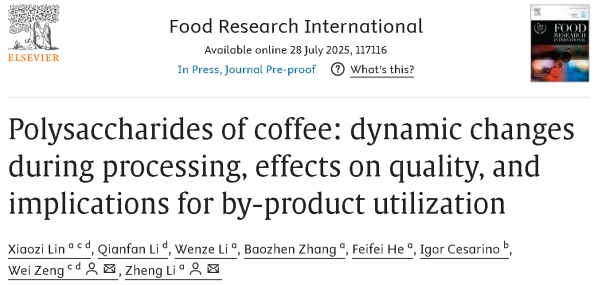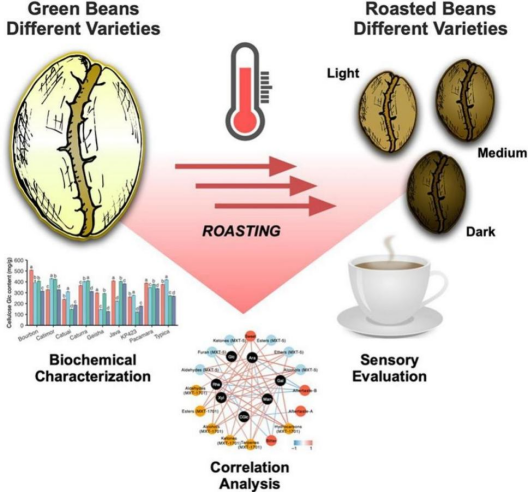As one of the world’s most popular beverages, the determinants of coffee quality have long been a focus of scientific research. A research team led by Li Zheng from the School of Agriculture at Yunnan University, in collaboration with a team led by Zeng Wei from the School of Life Sciences at Taizhou University and other research institutions, published recently a research paper titled “Polysaccharides of Coffee: dynamic changes during processing, effects on quality, and implications for by-product utilization” in Food Research International, a CAS Q1 Top journal. This study is the first to extensively investigate the diversity patterns of coffee polysaccharide composition and the correlation mechanisms between polysaccharide composition and coffee sensory quality.

Cell wall storage polysaccharides account for approximately 50% of the dry weight of coffee beans and are considered a key component determining coffee quality. However, their specific compositional profiles, variations among cultivars, their impact mechanisms on quality, and their transformation during the roasting process have not been thoroughly studied. Meanwhile, as the main soluble dietary fiber in coffee, polysaccharides contribute to health benefits such as the production of short-chain fatty acids through gut microbiota fermentation. Their value for reuse in areas like food additives and bioenergy, particularly from coffee grounds by-products, underscores their significant research importance in nutrition and sustainable development.

This study focused on coffee polysaccharides, conducting systematic polysaccharide component analysis on nine representative Arabica coffee bean varieties at different roast levels (covering three materials: beans, brewed coffee, and grounds). Multidimensional datasets clearly revealed significant differences among varieties and the profound impact of roast degree on polysaccharide characteristics. The research deciphered the correlation mechanisms between polysaccharide composition and coffee sensory properties, finding that the polysaccharide composition in both beans and brew is closely related to cupping characteristics, exhibiting a non-linear pattern dependent on roast level. These results provide a comprehensive depiction of polysaccharide composition across the coffee production chain and open new perspectives for understanding the chemical basis of coffee quality.
In recent years, coffee consumption in China has shown significant growth, with demand for specialty coffee continuously rising. Against this backdrop, townships such as Qingtian in Zhejiang, Baoshan in Yunnan, and Xinglong in Hainan have gradually developed cultural tourism industries centered around coffee culture, regularly hosting coffee expos. Yunnan Province accounts for over 98% of China’s coffee production.
CPC General Secretary Xi Jinping highly values Yunnan coffee industry, stating that “Yunnan coffee represents China’s coffee.” Yunnan Arabica coffee holds substantial market potential and is playing an increasingly important role in the international coffee market. In this context, research on coffee quality testing and improvement is particularly crucial. The correlation mechanisms between polysaccharide composition and coffee quality elucidated in this study hold significant theoretical importance for future improvements in Yunnan coffee quality and enhancing the economic value of its coffee industry.
The first author is Lin Xiaozi, a recently graduated Master’s student from Yunnan University. The corresponding authors are Professor Zeng Wei from the Institute of Biomass Polysaccharide Metabolism at TU and Associate Researcher Li Zheng from the School of Agriculture at Yunnan University. Master’s student Li Qianfan (jointly trained by Zhejiang A&F University and TU), Professor He Feifei from Yunnan University, and Professor Igor Cesarino from the University of São Paulo, Brazil, also participated in the work. The research was supported by the Taizhou “500 Elite” Innovation Project and the Yunnan University Professional Degree Postgraduate Practice Innovation Project.
Article link:
https://www.sciencedirect.com/science/article/pii/S0963996925014541